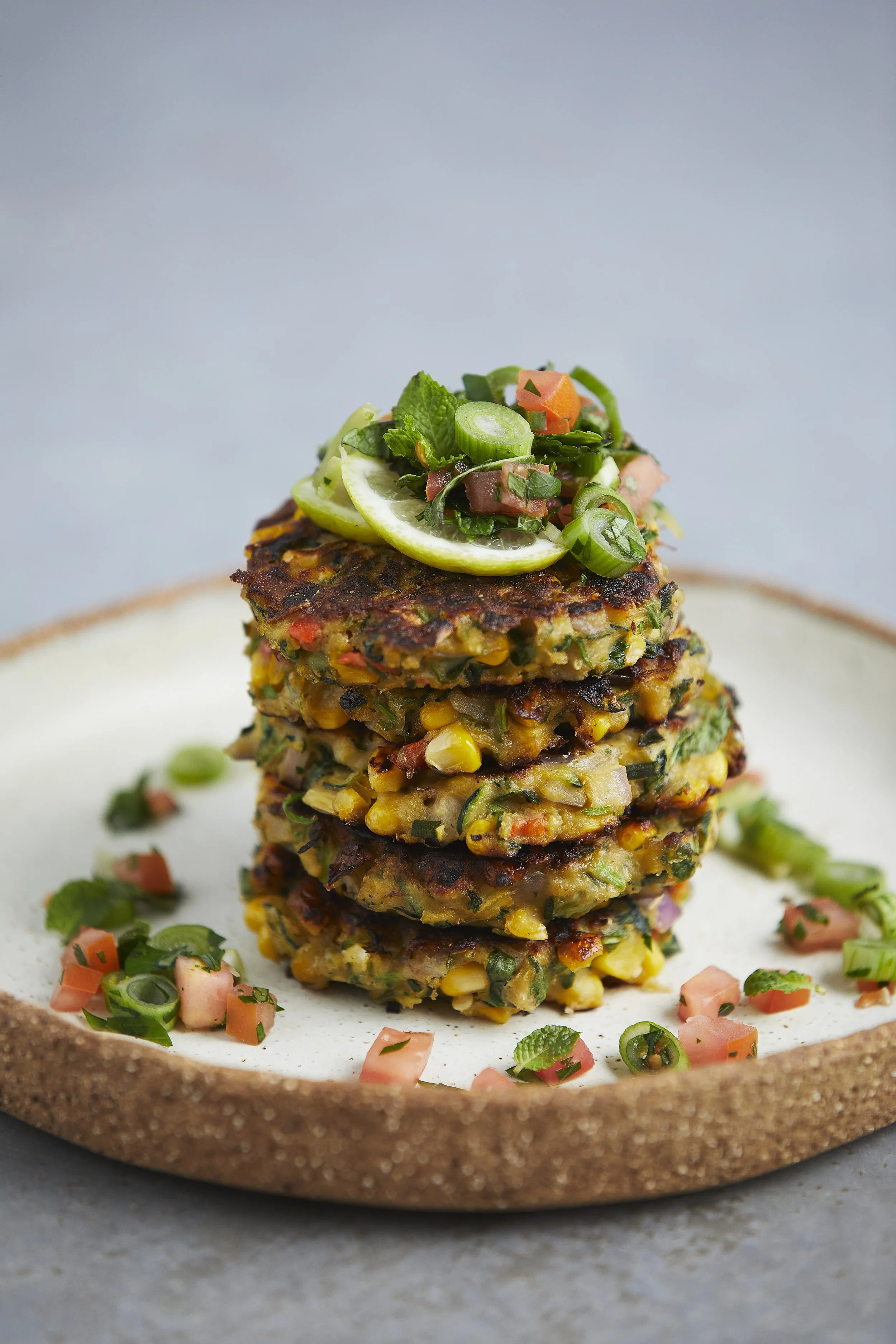A chef’s guide to herbs and Thai corn & zucchini fritters recipe
I am often asked… ‘How do I become a better cook?’
I see people following recipes instead of truly understanding how ingredients and methods work. So once a month, I'm going to share with you the alchemy of cooking. That way you can start creating in the kitchen with confidence.
This month we are chatting about herbs
The Art of Herbs
There's a moment in every cook's journey when herbs stop being garnishes and start becoming the backbone of flavour. They're not decoration—they're architecture. Understanding how to use herbs properly is what separates a dish that tastes good from one that tastes alive.
“Mastering herbs is about understanding their nature and respecting their strengths.”
Fresh vs. Dried: Know When to Use Each
The fresh versus dried debate isn't about one being better than the other—it's about understanding their different roles in your kitchen.
Fresh herbs are all about brightness and vibrancy. They contain essential oils that are volatile, meaning they dissipate quickly with heat. This is why fresh basil added at the beginning of a long simmer tastes like nothing, but torn over finished pasta tastes like summer. Use fresh herbs when you want that pop of flavour, that green brightness that wakes up a dish.
Dried herbs are concentrated and earthy. When herbs are dried, their water content evaporates, leaving behind more concentrated flavors—but different ones. Dried oregano isn't just "less fresh" oregano; it's a different ingredient entirely with deeper notes.
The Two Families: Hardy vs. Delicate
Understanding herb families changes how you cook with them.
Hardy herbs (rosemary, thyme, sage, oregano, bay leaves) have woody stems and can withstand long cooking times. Their oils are more stable under heat, actually becoming more mellow and integrated into dishes. Add these early—toss a sprig of thyme into your stock, add rosemary to your roast and bay leaves to work their magic in braises.
Delicate herbs (basil, coriander, parsley, chives, dill, mint, tarragon) have soft stems and tender leaves. Heat destroys their delicate oils and turns them muddy. These are your finishers, your last-minute heroes. Stir them into dishes just before serving, or scatter them over the top.
Building Layers: When to Add What
Great cooking is about layering flavors at different stages, and herbs are no exception.
At the start: Hardy herbs like thyme, rosemary, and bay leaves create your foundation. Add them when you're sweating aromatics or rubbed onto protein before roasting.
In the middle: Dried herbs (even delicate ones like dried basil or oregano) can be added mid-cooking to build body in sauces, soups, and stews.
At the finish: This is where delicate fresh herbs shine. Chopped parsley brightens a heavy stew. Torn basil makes tomato sauce sing. Fresh coriander transforms a curry. Snipped chives add a gentle onion note without harshness.
After plating: Some herbs are so delicate they belong on the plate, not in the pan. Micro herbs, delicate tarragon leaves, or whole coriander leaves added at the very end preserve maximum flavour and visual impact.
Thai corn & zucchini fritters with mint salsa
This is a really easy recipe that shows off how when you use herbs it elevates the dish in looks and taste.
Ingredients
Fritters
3 medium zucchini (300g), grated
1 tsp salt
1 cup rice flour
2 eggs, whisked
ke rnels from 2 medium corns, husk removed and
any hairs discarded (to make 300g of corn kernels)
1 small red onion (200g), finely diced
1 cup coriander leaves (60g), roughly chopped
1 fresh medium red chilli, minced
5 kaffir lime leaves, stems discarded and finely chopped
2 tbsp nutritional yeast
2 tbsp coconut sugar
1 tbsp tamari
1 tbsp fresh turmeric (20g), grated with skin on or
½ tsp of ground turmeric
2 tsp garlic, minced
2 tsp fresh ginger, grated with skin on
coconut oil, for frying
Salsa
3 medium tomatoes (300g), diced (it’s best if they are fresh
and not too soft)
1 spring onion, finely chopped including green tops
½ cup parsley (30g), chopped
½ cup mint leaves (30g), stems removed
½ lime, to make 1 tbsp of juice and 1 tsp of zest
pinch of salt and pepper
Garnish
½ lime, thinly sliced
Equipment
nut milk bag
Method
Fritters
Combine the zucchini and salt in a medium bowl and leave to draw out the liquid for 10 minutes. Put the zucchini, in batches, into a nut milk bag and squeeze out the water over the sink. Put the zucchini in a fresh bowl and set aside.
In a separate medium bowl, sift in the rice flour and then add the eggs, corn kernels, onion, coriander leaves, chilli, kaffir lime leaves, nutritional yeast, coconut sugar, tamari, turmeric, garlic, ginger and squeezed zucchini. Combine well until it becomes like a pancake batter.
Put 1 tablespoon of coconut oil in a medium to large fry pan and place on a medium-high heat. Add ¼ cup of the mixture and fry until you see the edges become brown before flipping. Once brown on both sides, transfer to a plate.
Repeat until the mixture is used up and serve straightaway with the salsa.
Salsa
Combine all of the ingredients in a bowl.
Garnish with the lime slices.






